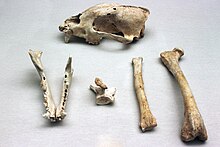European dhole
| European dhole | |
|---|---|

| |
| Skeletal remains dating back to upper Würm period from Cova del Parpalló, Gandía, Valencia, Spain. | |
| Scientific classification | |
| Domain: | Eukaryota |
| Kingdom: | Animalia |
| Phylum: | Chordata |
| Class: | Mammalia |
| Order: | Carnivora |
| Family: | Canidae |
| Genus: | Cuon |
| Species: | |
| Subspecies: | C. a. †europaeus
|
| Trinomial name | |
| Cuon alpinus †europaeus Bourguignat, 1868
| |
The European dhole (Cuon alpinus europaeus) was a paleosubspecies of dhole which ranged throughout much of Western and Central Europe during the Middle and Late Pleistocene. Like the modern Asiatic populations, it was a more progressive form than other prehistoric members of the genus Cuon, having transformed its lower molar tooth into a single cusped slicer. It was virtually indistinguishable from its modern counterpart, save for its greater size, which closely approached that of the grey wolf.[1]
It became extinct in much of Europe during the late Würm period,[1] though it may have survived in the Iberian Peninsula up until the early Holocene.[2] One factor contributing to its extinction may have been interspecific competition with grey wolves and other wolf-like canids.[3]
References
- ^ a b Kurtén, Björn (1968), Pleistocene mammals of Europe, Weidenfeld and Nicolson, pp. 111-114
- ^ Ripoll, P. et al. (2010), Presence of the genus Cuon in upper Pleistocene and initial Holocene sites of the Iberian Peninsula: new remains identified in archaeological contexts of the Mediterranean region, Journal of Archaeological Science, 37: 437-450
- ^ Petrucci, M. et al. (2012). The Middle-Late Pleistocene Cuon Hodgson, 1838 (Carnivora, Canidae) from Italy. Bollettino della Società Paleontologica Italiana, 51 (2), 2012, 137-148
